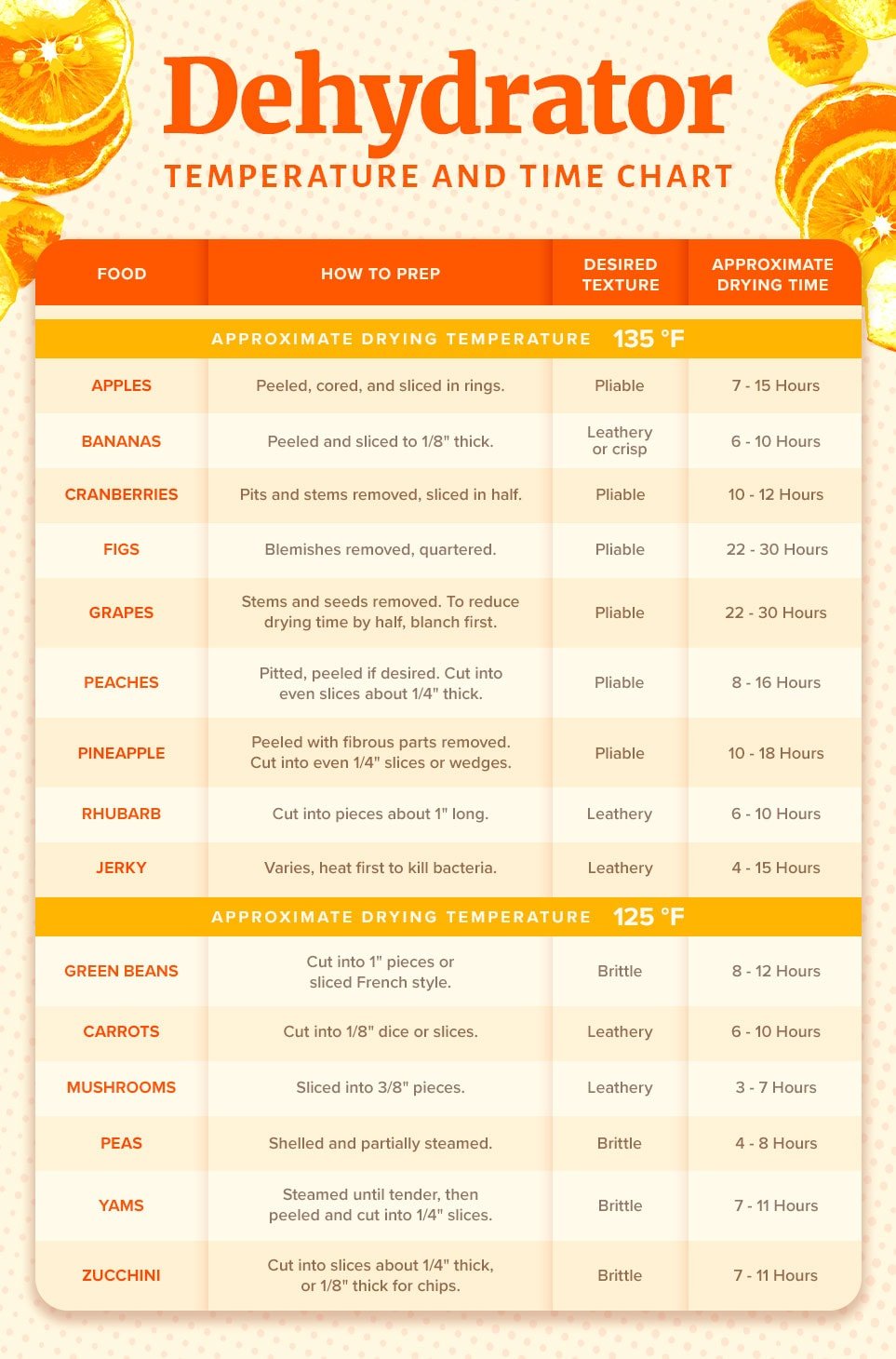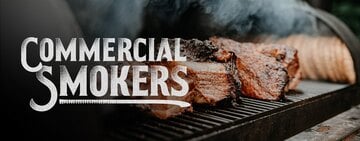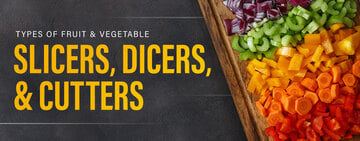
How to Pick the Best Food Dehydrator
Shop All Commercial Food Dehydrators
What Is a Dehydrator?
A dehydrator is a piece of equipment that pulls the moisture out of foods to prevent the growth of bacteria, yeast, and mold. It dries food at a lower heat level to preserve the nutrients and enzymes in the food. A dehydrator allows you to naturally extend the shelf life of food without the need to add preservatives.
How Do Dehydrators Work?
Dehydrators remove moisture from food without cooking it. This is accomplished by circulating air at very low temperatures using a fan that draws air in through the bottom or back of the unit and across the trays of food inside.
By simply removing the moisture, dehydrators help increase the shelf life of foods while maintaining a high nutritional value and intensifying their best flavors. This means that your recipes using dried foods can be healthier and more flavorful!

Benefits of a Dehydrator
Using a dehydrator can help increase food transparency in your restaurant because you know how your food is processed. Read on to learn about the health benefits of adding dehydrated foods to your menu, the cost savings and sustainability associated with dehydrators, and their ease of operation.
- Health Benefits: Drying foods helps to preserve the natural nutrients that they contain. Since dehydrators simply remove the moisture from food, they leave behind more healthy vitamins and enzymes. Plus, commercially prepared dried or canned foods often include salt or sulfur-based preservatives that can cause health issues for some consumers. Some also include monosodium glutamate (MSG) which many people are sensitive to, while others have added sugar that is not only unnecessary but also unhealthy. When using a dehydrator to make your own dried fruits, vegetables, herbs, meats, or other foods, you can choose which additives to include (or exclude) from your recipes.
- Cost Savings: By drying and preserving excess foods for use in recipes or as healthy snacks to sell, you can use up products that might otherwise go to waste. Dried food has a longer shelf life than fresh foods, so you can buy it in bulk and not worry about throwing away the excess. In addition, some dried foods or ingredients can be expensive to purchase pre-made. If your budget is tight, choosing to buy fresh foods and dry them yourself could help you save money in the long run.
- Ease of Use: While some trial and error is necessary to find a recipe you like since the drying process is so slow, it is difficult to ruin a batch of food beyond repair. Many manufacturers offer in-depth resources that can help you properly prepare, dry, store, and utilize different types of foods, making it easy to get started.
Oven vs Dehydrator

Since they are specifically designed for drying foods, dehydrators can reach lower temperatures than ovens can. Standard food dehydrators work at a temperature range of 85 to 160 degrees Fahrenheit, but some specialty dehydrators can be set to temperatures as low as 20 degrees Fahrenheit. Most ovens have a low-temperature limit between 150 to 200 degrees Fahrenheit, which is too hot for drying many foods. Using too high a temperature setting can end up cooking the food rather than simply removing the moisture. This results in the loss of more of the flavor and nutrients than would be lost by using a dehydrator.
Food dehydrators tend to be much more energy efficient than ovens as well. When you consider the difference between running a 1000W dehydrator for 12 hours versus a 5000W to 38,000W convection oven for the same time, the dehydrator wins out on energy use alone.
Effective dehydrating needs precise temperatures over an extended period. While certain high-end combination ovens offer the temperature and humidity control required to dry foods, most convection ovens and standard ovens can't hold consistent temperatures for long periods. Additionally, hot and cold spots are unavoidable in most ovens, which is an issue that is less problematic in dehydrators.
What to Look For in a Food Dehydrator

There are several things to keep in mind when you are looking for a dehydrator for your business. While you may not need a unit with all the bells and whistles, it's a good idea to know what to look for in a food dehydrator so you can make the most informed decision.
- Wattage: The lower the wattage, the less energy an appliance uses, but the longer it takes to heat up and do its job. Higher wattage units will heat up more quickly and are more powerful, but they may also be more expensive to purchase and run. For more information about wattage and electrical terms, see our helpful guide to amps, volts, and watts.
- Size and Space: Pick a dehydrator that fits your space. Consider the unit's dimensions - top to bottom, front to back, and side to side - to make sure it's going to fit in the spot you've chosen.
- Capacity: Since drying food takes a long time, you'll want to make sure that the unit you choose can keep up with the demand of your operation. If you are only drying a few herbs for cooking, a small dehydrator will suffice. If you want to start a jerky business, you may need several large commercial units to handle the volume.
- Materials: Many commercial dehydrators have a durable stainless steel construction to make sure they can take a beating in a restaurant environment. If you won't use your dehydrator frequently or if the price is a concern, models with a less expensive plastic body are available.
- Timers: Many dehydrators come with a simple on/off switch, which is great when you can keep a close eye on the drying process. If you'd prefer to load the unit up and forget about it, a model with a built-in timer is a great choice. Some units even have automatic shut-off features that make it easy to dry foods overnight without over-drying them.
- Stackable: If you need more capacity but don't have the floor space for a large unit, consider choosing a stackable countertop dehydrator. By purchasing multiple units that can stack together, you'll use the available vertical space to your advantage and not cut into high-traffic areas.
Food to Dehydrate
Depending on the food dehydrator you choose, you can dry fruits, vegetables, grains, meats, herbs, and flowers. Dehydrators are great for making house specialties like granola, fruit leather, or dried fruit, but they can also be used for recipes that are otherwise difficult to make. For Indonesian tempeh, Japanese natto, fresh yogurt, and other foods that require constant low, warm temperatures for an extended time, a dehydrator is an easy-to-use, low-cost way to start expanding your menu into these areas.
When choosing between different dehydrators, be aware that round-style dehydrators are best for drying solid items like fruits, herbs, and meats. They're great for drying but don't do well with pans of yogurt or liquid products like fruit leathers.
Dehydrator Temperature and Time Chart
Cut food no more than 1/4" thick and spread in a single layer on a tray for the most efficient drying. The chart below lays out some commonly-processed food in a dehydrator, along with some of the best ways to prepare them, the ideal temperatures for drying them, and a general idea of how long the process might take.
Keep in mind that the times listed are approximate and you may experience different results. Several factors can modify the drying times of various foods - ambient temperatures and humidity, the moisture level in the food, and how the food is prepared are some of the biggest.

Food Dehydrating Tips
Below are a few tips to consider when dehydrating food.
- Plan Ahead: Different foods dry at different rates. A peach, for example, will dry much more slowly than shelled peas or herbs. For the most efficient drying times, try to dry similar foods together.
- Allow Enough Time: Dehydrating food takes time, no matter what product you're working with. Budget enough time to completely dehydrate the food before packaging or using it. Food that isn't completely dry will go bad much more quickly.
- Avoid Over-Drying: If your unit has a timer, set it to prevent over-drying. If it doesn't have a timer, keep a close eye on the drying process so your foods don't become over-dried.
- Don't Overload: When you are getting ready to load up your dehydrator, the temptation may be to pack as much food into the unit as you can. Instead, arrange the food in a single layer and leave some space between each item. Do this to ensure the food dries evenly in the proper amount of time.
- Rehydrating: Most dried foods offer versatility. Serve as they are, or you can rehydrate certain foods for soups, baked goods, and other recipes. To do this, soak them in clean, filtered water until they reach the consistency you want.
Related Resources

June 2024 WebstaurantStore Coupon Code
Summer is almost here, and to celebrate Webstaurantstore is offering a variety of amazing monthly deals! In June, you'll discover incredible prices on glassware, flavoring syrups, disposable packaging supplies and much more! Take a look at our selection of sale items below and don't forget to enter the code SUMMERSALE at checkout to enjoy savings of up to 25%! We're also excited to introduce the new Webstaurant Rewards® Visa Business Card ! Sign up for a new card today and start earning rewards on every WebstaurantStore purchase. Use Coupon Code: SUMMERSALE DaVinci Gourmet Classic Passion Fruit Flavoring / Fruit Syrup 750 mL reg. $6.89 Each $5.86 Shop Now Monin Hydration Boost Syrup 1 Liter reg. $12.49 Each $11.24 Shop Now Fanale Strawberry

Commercial Smokers Buying Guide
Whether you're new to meat smoking or you're looking to upgrade your current smoker, the amount of restaurant smoker options out there can make it difficult to decide. Fuel type, location, and size are just some factors to consider when choosing the best commercial smoker for your business. This guide will break down the different types of commercial smokers so that purchasing a smoker can become an easy task.

Types of Fruit and Vegetable Cutters
You'll hear fruit and veggie cutters referred to by many names like slicers, dicers, and choppers. Some cutters are specialized to process one type of fresh produce or perform a single cut. Other models are all-purpose cutters that can be used on a variety of fruits, vegetables, and even cheese. The one thing they all have in common is that they will save you precious time in the kitchen. You can produce consistent, quality cuts that ensure customer expectations are met, portions are controlled, and food waste is reduced to a bare minimum. Keep reading to learn more about the types of cutters, or check out our commercial vegetable slicer reviews . Shop All Fruit and Vegetable Cutters
- Topics 1366
- Industrial 55
- Troubleshooting Guides 21
- Restaurant Management 130
- Bar Management 58
- Catering Tips 37
- Bakery Management 42
- Food Trucks & Concessions 49
- Advertising & Marketing 37
- Eco-Friendly Tips 11
- Facility Layout & Design 42
- Coffee Shop Tips 29
- Installation & Maintenance 52
- Janitorial & Pest Control 30
- Safety & Sanitation 89
- Startup Tips 104
- Menu Design 10
- Kitchen & Cooking Tips 84
- Hospitality Management 24
- Pizza & Sandwich Shop Tips 36
- Smallwares 37
- Food Prep 90
- Tabletop Items 17
- Disposables 22
- Calculators & Tools 6
- Consumables 52
- Warewashing & Laundry 18
- Cooking Equipment 92
- Food Storage & Refrigeration 51
- Beverage Equipment 35
- Office Supplies 6


